Guardian Map Approach to Feasible Range of Static Stability Margin of Hypersonic Flight Vehicles with Input Saturation
Abstract
Static stability margin is a critical parameter in flight control design. The feasible range of it must cover the uncertainty through the flight. To reasonably identify the feasible range of static stability margin in advance, an approach based on guardian maps is proposed for flight control of hypersonic flight vehicles with input saturation. First, the model of hypersonic flight vehicle (HFV) is established as a parametric plant. Then, flying quality requirements for the closed-loop system are formulated as inequality constraints using guardian maps. Moreover, by using linear matrix inequality, the saturation of elevators is taken into account in the integrated control of attitude control. The prescribed minimum of static stability margin that ensures the flying quality of hypersonic flight vehicles with input saturation is obtained. Furthermore, from the prospective of integrated control, it is shown that the feasible range of static stability margin can be enlarged by changing aerodynamic characteristics. The effectiveness of the proposed approach is validated by numerical simulation.
1. Introduction
Large flight envelopes [1], unstable longitudinal dynamics with input saturation [2], and environmental uncertainty [3] lead to a great of difficulty in flight control system design of hypersonic flight vehicles (HFV). Besides, tracking control for HFV with model uncertainties for prescribed performance is a challenging task [4]. Plenty of advanced control methods have been investigated to address the flight control problems [5, 6]. The majority focuses on the adaptive nonlinear approach for non-affine models with mismatched disturbance [7, 8] and large-envelope tracking problem with global stability and prescribed performance [9–11]. The global stability can be hardly guaranteed in closed-loop system with input saturation since the longitudinal dynamics is inherently unstable for hypersonic flight [12]. Hence, the stability region of a closed-loop system should be confirmed beforehand, and the feasible range in which the closed-loop performance remains must be identified [13].
Static stability margin is a critical parameter in overall design and dramatically affects the performance of flight control system. It may be actively determined by the designer or passively changed according to the flying environment. Releasing static stability margin can improve the flight performance. However, relaxed static stability margin results in stability problem in the flight control system, especially for an unstable plant with limited control authority [14]. The achievable flight stability and performance is closely related to the control authority [15], especially input saturation, control rate, and control failure [16]. Many anti-windup strategies have been proposed, such as introducing auxiliary dynamic systems to regulate the inputs [17]. Instability with input constraints of HFV inflicts serious challenge on the flight control system design. Besides, both the aerodynamic centre and the centre of gravity vary uncertainly with the change of flight environment. Hence, it will be extremely useful for aircraft design and control that the feasible range of static stability margin (or minimum static stability margin) is determined in advance.
Guardian maps were introduced by Saydy et al. as a unifying tool for the study of generalized stability of parameterized families of matrices or polynomials [18]. The guardian map approach for control system design identifies the boundary of controller gain with a suitable initial solution [19]. A feasible solution of the controller gains is restricted by inequalities if the topological structure of the null space for guardian maps remains. According to this property, Sausslé et al. proposed a longitudinal flight control method with handling quality requirements, where the controller gains are automatically tuned using guardian map approach [20]. What is more, guardian maps can be utilized in scheduling or switching algorithms for controller gains over a wide flight range [21, 22].
The superiority of the guardian map approach lies in its capability to directly identify the stability region [23]. It will be more concise and efficient than solving a bunch of pole-placement problems, especially for high-dimensional parametric systems. We use a linearized HFV model in a cruising flight condition to examine the proposed method. Input saturation is formulated as linear matrix inequality (LMI) [24]. The boundary of static stability margin is identified by solving a generalized eigenvalue problem of LMI [25], and the controller gain that maximizes the robustness against static stability is obtained simultaneously.
Motivated by the aforementioned observations, which summarizes the challenges the control flight control system design of HFV and the capacity of guardian maps, this paper proposes an approach to calculate the feasible region of static stability margin of HFV based on guardian maps. The predominant contributions of this paper can be summarized as follows: (1) Instead of solving a bunch of pole-placement problems, this paper proposes a more concise and self-contained approach for solving parametric stability problem. (2) Closed-loop performance is analytically formulated using guardian maps, which enables rough assessment of flight control system before the concrete controller design. (3) With the proposed approach, stability concerns can be integrated in the overall design of HFV for more reliable design against the abovementioned control problem in advance.
The remainder of this paper is structured as follows. The longitudinal dynamic model of an HFV with input saturation constraints is considered in Section 2. The basic principles of guardian map theory are briefly reviewed in Section 3, and flying quality requirements are constructed as inequality constraints on the basis of guardian maps. The procedure for determining the feasible range of static stability margin for a linearized attitude dynamic model is explored in Section 4. Simulation results are discussed in the next section, and conclusion comes at last.
2. Guardian Map Approach to Stability Analysis
2.1. Guardian Maps: Brief Review
Guardian maps are used to address the generalized stability problem for parametric families of matrices. The value of a guardian map in the domain Ω is sign-invariant and vanishes on the boundary of Ω. Let be a parameter vector, where Ru is a path-wise connected subset of Rk, and A(r) is a matrix which depends continuously on r. Given an open set Ω and its guardian map νΩ, we can calculate the boundary conditions for r that A(r) lies within SΩ by solving the null space of corresponding guardian maps.
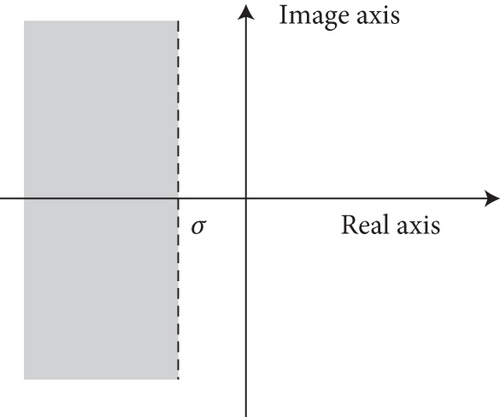
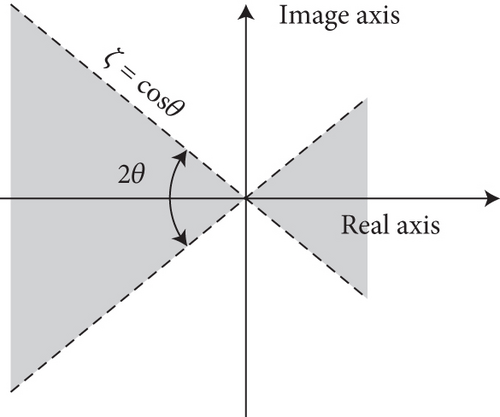
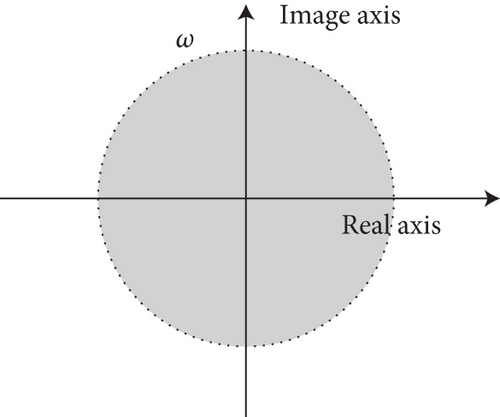
Guardian map of any region that is generated by the intersection of these classic domains can be expressed as the product of the above functions. Considering requirements on flying quality are mainly defined as time constant, damping ratio, and natural frequency, the performance of flight control system can be addressed by guardian maps in terms of generalized stability.
2.2. Generalized Stability Defined by Flying Quality
Practical considerations related to damping ratio, bandwidth, and vehicle handling quality can be expressed as the generalized stability. The flying quality (FQ) criteria for the short-period mode considered in this work are the damping ratio ζsp, natural frequency ωsp, and pitch attitude bandwidth ωBWθ. Boundaries for these criteria defined by military standards are listed as follows (see Table 1).
| ζsp | ωsp | ωBWθ |
|---|---|---|
| 0.35~1.30 | >0.87 rad/s | >1.5 rad/s |
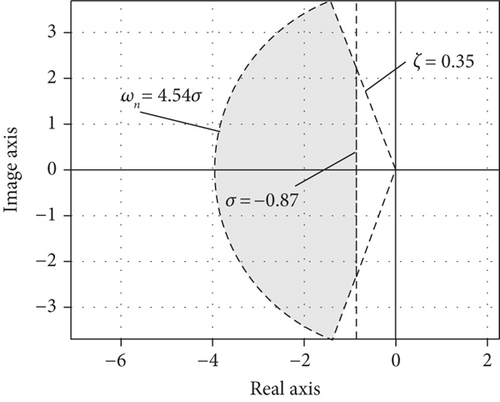
Guardian maps provide an extremely powerful tool to parametric stability analysis. They extend the Hurwitz’s stability to any desired region in complex plane, which affords the robust analysis of closed-loop performance against parametric uncertainty. The formulation of parametric plant is then presented in the next section.
3. Parametric Model with Input Saturation
In this work, we apply a reduced complexity control-oriented model (COM) for control design and stability analysis, and a high-fidelity simulation model (SM) for numerical simulation [27].
3.1. Longitudinal Dynamics with Input Saturation
3.2. Parametric Model for Static Stability Margin
The longitudinal stability is significantly influenced by the distance between the centre of gravity (CG) and the centre of pressure (CP). Static stability margin is defined as Kn = (xCP − xCG)/c to qualify stability, where xCP is the axial distance form CP to the leading edge of the fuselage, and xCG is the axial distance from the CG. A negative static stability margin indicates an instable plant.
Closed-loop stability and performance are affected by the feedback gain and Kn. The feasible range for these parameters maintaining closed-loop performance is obtained by guardian map theory.
However, an elegant solution is acquired based on the generalized eigenvalue problem of LMI when the inequality constraints regarding parameter Kn have the linear from of first order. An illustrative example of control system design is provided in the next section.
4. Static Stability Margin Analysis in the Closed-Loop System
The following section presents a control methodology that can minimize the static stability margin of longitudinal dynamics. We use a classic decentralized inner-outer loop control system architecture for attitude regulation to illustrate controller design process (see Figure 3). The inner loop controller is full state feedback control, and the outer loop controller is a PI controller. The gains of the inner-loop controller is are donated as K = [Kα, Kq].
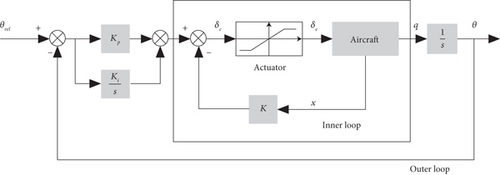
4.1. Constraints with Requirements on FQ and Input Saturation
4.2. Boundary of Static Stability Margin
The controller gain that minimizes the static margin is obtained by solving the generalized eigenvalue problem of LMI, and the minimum static stability margin is determined simultaneously.
The controller gain obtained from the proposed problem Equation (24) can only guarantee the control specification on stability margin σ, while other FQ requirements expressed as guardian maps are examined afterwards.
The gains Kα, Kq for the inner loop are calculated by solving the generalized eigenvalue problem (Equation (24)). Kp, Ki for the outer loop are tuned automatically based on guardian maps to maintain FQ. The simulation results and analysis are provided in the next section.
5. Simulation Results
In this paper, we apply the reduced complexity control-oriented model (COM) for robust analysis and control law design, and a high-fidelity simulation model (SM) for numerical simulation. Table 2 provides parameters of the HFV model and estimated values of stability and control derivatives used in this work [27].
| No | Parameters | Symbols | Nominal values | Units |
|---|---|---|---|---|
| 1 | Fuselage length | L | 100 | ft |
| 2 | Axial distance of the CG from the leading edge | xCG/L. | 55 | % |
| 3 | Reference area | S | 17 | ft2 |
| 4 | Mean aerodynamic chord (MAC) | c | 17 | ft |
| 5 | Shift distance of scramjet engine | zT | 8.36 | ft |
| 6 | Static stability margin | Kn | -55.01 | % |
| 7 | Stability derivatives | CLα | 4.6773 | rad-1 |
| 8 | Control derivatives | CLδ | 0.7622 | rad-1 |
| 9 | Net control derivatives |
|
-1.7090 | rad-1 |
Control system design is carried out for the cruising flight condition h = 85000 ft, Ma = 7.8497. The trim conditions are listed in Table 3. The maximum and minimum deflections of the elevators are assumed to be ±20°. Thus, the saturation value of the control input for the cruising flight is . Compared with pole-placement technique, the superiority of the guardian map approach lies in its capability to automatically define the feasible range of the controller gain instead of a specific value. The feasible range of the controller gain is calculated with LMIs (Equations (18)–(20)) by guardian maps (see Figure 4). The admissible controller gain for a specific plant must lie in the region regardless of the design method, such as LQR methodology or other optimal control design methods.
| States | h (ft) | V (ft/s) | α (deg) | θ (deg) | q (deg/s) | δ (deg) | ϕ (a.u.) |
| Values | 85000 | 7702 | 1.2046 | 1.2046 | 0 | 12.6480 | 0.2372 |
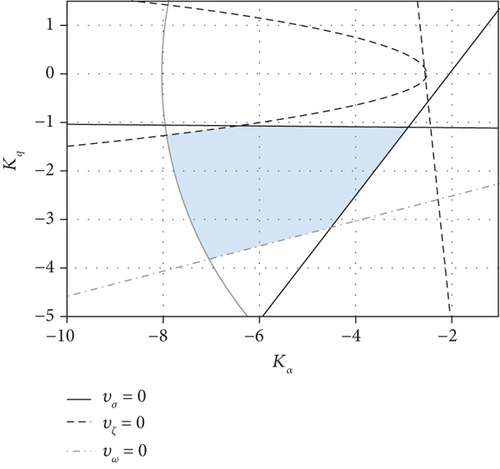
The feasible range of controller gains varies with the change of static stability margin. The closed-loop system requires a higher feedback gain to stabilize the plant as the decrease in static stability margin. Therefore, the feasible range shrinks accordingly and even vanishes with limited control input. Minimum static stability margin controller (MSMC) design methodology is to find the controller gain that minimizes static stability margin while still maintain FQ of the closed-loop system with limited input. We also provide an illustrative example of the proposed controller for a nonlinear model of the HFV and compare the control performance obtained using MSMC and a linear quadratic regulator (LQR) [29].
5.1. Comparison of LQR and MSMC
The performance of the closed-loop system with two controllers is examined with the decrease in the static stability margin. The lower limit of ζsp and ωsp is shown as a dotted line in Figure 5. The closed-loop system becomes unstable when the natural frequency is zero. The static stability margin, at which ωsp vanish, is regarded as boundary for stable closed-loop system.
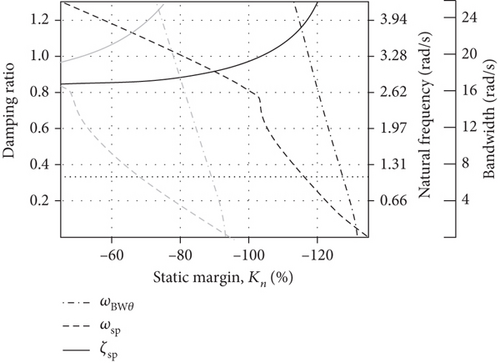
A comparison of the feasible range of static stability margin between LQR and MSMC is shown in Figure 6. The dashed-dotted line in Figure 6 indicates the nominal value of the static stability margin of COM. Two feasible ranges of the static stability margin are present. The smaller one defines the boundary that the closed-loop system satisfies FQ requirements, and the larger one establishes the limitation that the close-loop system remains stable with input saturation.
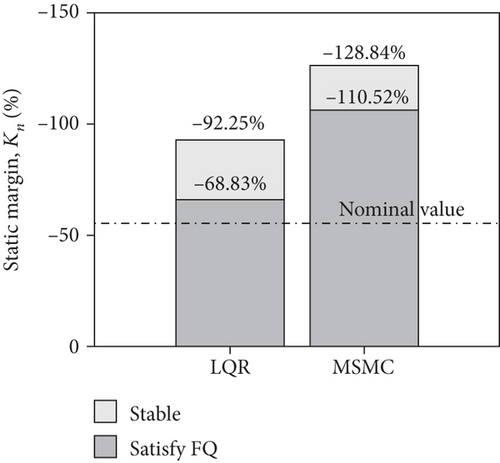
The step responses of the pitch angle of the nonlinear system with different static stability margins are shown in Figure 7. ζsp > 0.35 is equivalent to that in which the overshoot is less than 28.5%. The performance of the closed-loop system with MSMC still satisfies FQ requirements with admissible input, whereas the control input from the LQR is beyond the admissible range, which is shown as dashed-dotted lines in Figure 7(b). Furthermore, the overshoot of the step response with LQR control reaches 47%. Although the closed-loop system with LQR does not satisfy FQ, the stability of the closed-loop system can still be maintained with sufficient control authority. Therefore, the primary reason for the instability issue of HFV dynamics is control saturation.
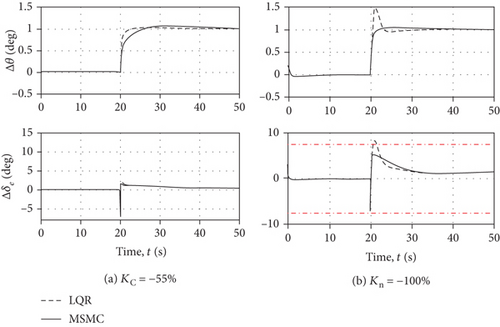
5.2. Feasible Range of Static Stability Margin
Given input saturation, the minimum static stability margin can be determined via the proposed method in the cruising flight condition. The nominal value of Kn is −55%. The minimum static stability margin with input saturation in cruising flight condition is 110.52%. Thus, the CG of SM can shift backwards by up to 110.52%. However, the trimmed elevator deflection increases as CG shifts afterwards to counteract the nose-up pitching moment. Therefore, the saturation value of elevator deflection decreases as static stability margin decreases, as shown by the dashed-dotted line in Figure 8.

The interaction point in Figure 8 is regarded as the minimum static stability margin for the cruising flight condition, which is determined to be −76%. The graphical representation of the HFV model is shown in Figure 9.
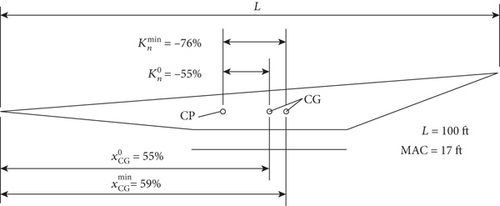
The significance of this work is the determination of the feasible range of static stability margin characterized by , which is directly determined by the input saturation and affected by the control derivatives of the model. The effect of the control derivatives on is investigated in the next subsection.
6. Impact of Control Derivatives on
Instability with input constraints of HFV inflicts serious challenge on the flight control system design. The static stability margin is one of the most critical parameters both for overall design and flight control system. With the proposed approach, the lower limit of static stability margin has been confirmed. However, there may be a mismatch between the prescribed flight performance and stability. Hence, the approach of integrated design emerges to address the issue. This subsection will discuss the influence of aerodynamic characteristics on the feasible range of static stability margin.
The nominal values of the control derivatives of the baseline model are and . The variation in the minimum static stability margin over the control derivatives for cruising flight is shown in Figure 10. The most effective approach to improve the control performance by releasing the static stability margin is to adjust the control derivatives along the gradient direction as shown in Figure 10.
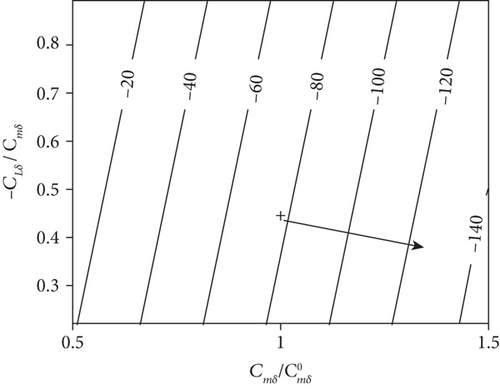
The control derivatives are determinant factors affecting the closed-loop stability. The first one is Cmδ, followed by the ratio of control derivatives CLδ/Cmδ. The location of the control surfaces is more important than the size in addressing the closed-loop stability. Thus, the control surfaces are expected to be located at the rearward-most position of the vehicle.
7. Conclusions
In this paper, an analytical approach for determining the feasible range of static stability margin has been proposed based on guardian maps and linear matrix inequality. The feasible range of static stability margin is characterized by the minimum static stability margin, which is obtained by formulating an optimal problem. Meanwhile, flying quality requirements and input saturation are reconstructed as nonlinear inequalities. Simulation results show the effectiveness of the proposed approach for defining the feasible range of static stability margin. Given the model of hypersonic flight vehicles by Parker, the maximum relative distance of centre of gravity from the nose is shown to be 59% when saturation of deflection of elevators is ±20°, whereas the nominal value is 55%. The primary reason leading to instability issue of HFV dynamics is input saturation. Besides, the control derivatives are also determinant factors affecting the closed-loop stability. The adjustment direction of the aerodynamic characteristics is also indicated to improve control performance. To enlarge the feasible range of static stability region, the control surfaces are expected to be located at the rearward-most position of the vehicle.
Conflicts of Interest
The authors declare that there is no conflict of interest regarding the publication of this paper.
Acknowledgments
This work was supported by the National Natural Science Foundation of China (grant number 51675264), the Natural Science Foundation of Jiangsu Province for distinguished young scholars (grant number BK20190017), the Jiangsu Planned Projects for Postdoctoral Research Funds (grant number 2019K286), the Six Talent Peaks Project in Jiangsu Province (grant number KTHY-025), the open funds of BISME, and the Fundamental Research Funds for the Central Universities (grant number NS2018052).
Appendix
Open Research
Data Availability
The hypersonic model data used to support the findings of this study are included within the article, and the result data are available from the corresponding author upon request.




